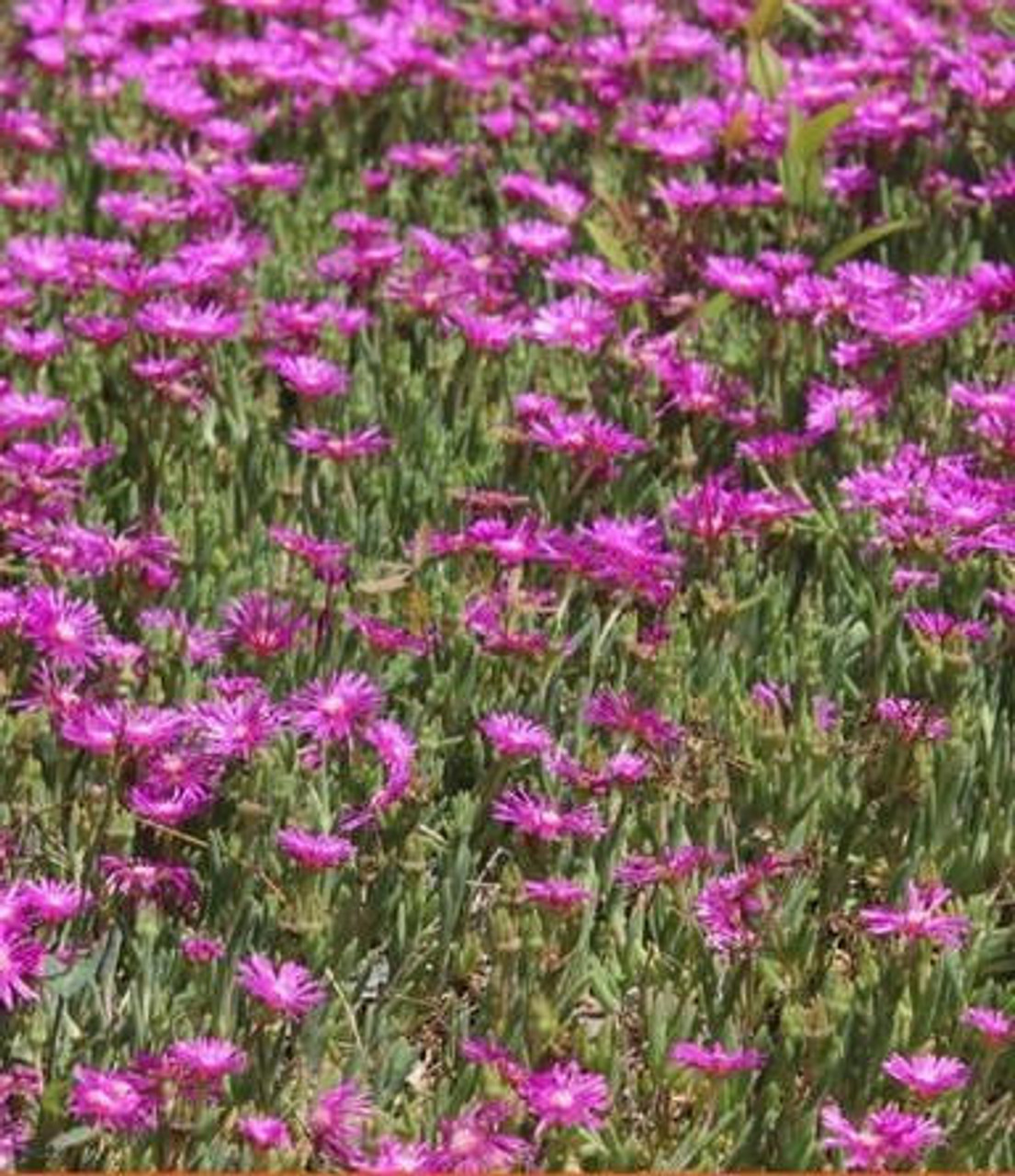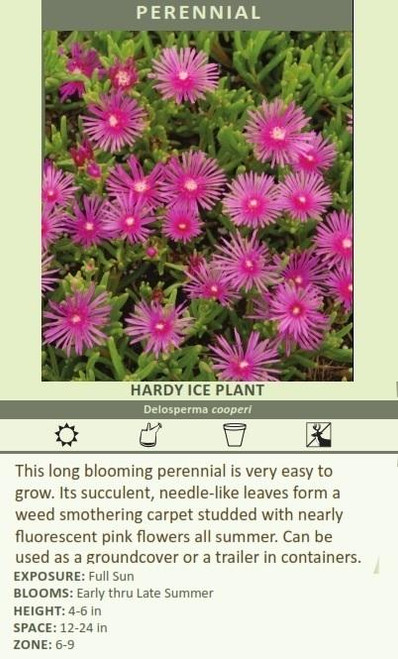Product Description
Delosperma cooperi (3.5-inch pots)
Common Name: Hardy Ice Plant
Delosperma cooperi, also known as the trailing ice plant, hardy ice plant, or pink carpet, is a succulent plant native to South Africa. It is a mat-forming plant that typically grows to 3-6 inches tall and spreads to 24 inches or more. The leaves are fleshy and linear, and the flowers are daisy-like and bright red-purple.
Delosperma cooperi is a drought-tolerant plant that thrives in full sun and well-drained soil. It is also salt-tolerant and can be grown in coastal areas. The plant is evergreen in warmer winter climates, but may become semi-evergreen or dormant in colder climates.
Delosperma cooperi is a popular ornamental plant that is used in rock gardens, borders, and as a groundcover. It is also a good choice for xeriscaping.
Plant type: Succulent
Height: 3-6 inches
Spread: 24 inches
Space the plants 9-18 inches apart
Sun exposure: Full sun
Soil type: Well-drained
Drought tolerance: High
Salt tolerance: Moderate
Winter hardiness: Zones 7-10
Bloom time: June-September
Flowers: Daisy-like, bright red-purple
Rock garden plant, Border plant, Groundcover, Xeriscape plant
- Plant Delosperma cooperi in the spring, summer, or fall. However, if planting in the fall, make sure plants have time to establish before winter.
- If planting in a pot, use a well-draining potting mix.
- Mulch around the plants to help retain moisture and suppress weeds.
- Water the plants regularly, especially during first year. Once the plants are established, they can tolerate some drought.
- Delosperma cooperi is not a heavy feeder. A light application of fertilizer in the spring will help promote flowering.
With proper care, Delosperma cooperi will thrive for many years. It is a low-maintenance plant that is perfect for adding color and interest to your garden. Delosperma cooperi is relatively pest and disease-free. However, it can be susceptible to mealybugs and scale, treat with an insecticidal soap or neem oil.
Delosperma cooperi, commonly known as Ice Plant, is a vibrant and hardy succulent groundcover that thrives in sunny, dry conditions. Here's a closer look at this popular plant:
Appearance:
- Flowers: Delosperma cooperi produces a profusion of bright, daisy-like flowers in shades of magenta, purple, or pink. The flowers typically have a yellow center and bloom from late spring to fall, creating a vibrant display.
- Foliage: The plant features succulent, cylindrical leaves that are typically green or bluish-green in color. The leaves are fleshy and help the plant store water, making it drought-tolerant.
Growth Habit:
- Delosperma cooperi is a low-growing, spreading succulent that forms a dense mat, typically reaching about 3-6 inches tall and spreading 1-2 feet or more.
Growing Conditions:
- Sunlight: This plant thrives in full sun, needing at least 6 hours of direct sunlight per day to bloom its best.
- Soil: Delosperma cooperi prefers well-drained soil and is adaptable to various soil types, including sandy or rocky soils. It's important to avoid heavy clay soils that retain moisture, as this can lead to root rot.
- Moisture: This plant is drought-tolerant and prefers infrequent watering. Allow the soil to dry out completely between waterings.
- Hardiness: Delosperma cooperi is hardy in USDA Zones 6-10, making it suitable for a wide range of climates.
Special Features:
- Drought Tolerance: The succulent leaves of Delosperma cooperi store water, making it highly drought-tolerant and a great choice for water-wise gardens.
- Long Bloom Season: This plant has a long bloom season, providing color from late spring to fall.
- Groundcover: Its spreading habit makes it an excellent groundcover, helping to suppress weeds and prevent erosion.
- Low Maintenance: Once established, Delosperma cooperi is a relatively low-maintenance plant, requiring minimal care.
Uses in the Garden:
- Rock Gardens: Delosperma cooperi is a perfect fit for rock gardens, where it can spill over rocks and add a touch of vibrant color.
- Borders: It can be used to edge borders or pathways, creating a colorful and drought-tolerant border.
- Slopes: Its spreading habit makes it ideal for stabilizing slopes and preventing erosion.
- Containers: Delosperma cooperi can also be grown in containers, allowing you to enjoy its beauty on patios or balconies.
- Green Roofs: It's also a good choice for green roofs, where its drought tolerance and low maintenance requirements are valuable assets.
Tips for Growing Delosperma cooperi:
- Planting: Plant in spring or fall in a sunny location with well-drained soil. Space the plants about 12-18 inches apart.
- Watering: Water sparingly, allowing the soil to dry out completely between waterings. Avoid overwatering, which can lead to root rot.
- Fertilizing: Delosperma cooperi doesn't require heavy fertilization. A light application of a balanced fertilizer in spring is usually sufficient.
- Winter Protection: In colder climates, provide some winter protection, such as a layer of mulch, to help the plant survive the winter.
Overall, Delosperma cooperi, or Ice Plant, is a vibrant and versatile succulent groundcover that thrives in sunny, dry conditions. Its drought tolerance, long bloom season, and low maintenance requirements make it a popular choice for gardeners seeking a colorful and easy-to-care-for plant.
Other Details
The most important part of the plant is its root system. Healthy roots are the foundation of a healthy, vibrant plant. The type of plug container used is based on the specific needs of the plants. Perennials offered as bare root traditionally perform better when planted as bare root.Planted in a specialized mix, potted plants have well established root systems. Top growth stage will vary depending on the current life cycle and time of year when shipped. In Winter and early Spring dormant plants may be shipped. Dormant plants may be planted right away, even before the last frost date.
Most bare root varieties are field grown for at least one season, though Hemerocallis and Hosta are grown for two seasons. The bulk of the soil is removed during the harvesting process and the tops of most varieties are trimmed back to the crown. They are graded, packed in shredded aspen or sphagnum moss and stored in freezers until ready to be shipped.
See our Container Sizes and Bare Root Perennials pages for more information.
Plant information and care is provided in the Overview section, Plant Genus Page and general information is provided in the Planting Care & Guides. Additional questions can be asked on each Plant page.
Plant Spacing: Using the maximum mature spread or width of a plant to guide spacing, ensures space to grow to full size. To fill an area sooner, plant them closer together. Just remember, future thinning or transplanting may be needed.
Water: Keep a close eye on newly planted perennials, especially throughout the first growing year. Most early plant loss is due to too much or too little water!
















